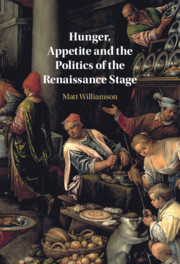Book contents
- Hunger, Appetite and the Politics of the Renaissance Stage
- Hunger, Appetite and the Politics of the Renaissance Stage
- Copyright page
- Contents
- Acknowledgements
- Introduction
- Chapter 1 Thinking through Hunger and Appetite in Renaissance England
- Chapter 2 Service
- Chapter 3 The Food Gift
- Chapter 4 Sexual Desire
- Chapter 5 Female Food Refusal
- Chapter 6 Imperial Appetites
- Chapter 7 Revolt
- Conclusion
- Bibliography
- Index
Chapter 5 - Female Food Refusal
Published online by Cambridge University Press: 28 May 2021
- Hunger, Appetite and the Politics of the Renaissance Stage
- Hunger, Appetite and the Politics of the Renaissance Stage
- Copyright page
- Contents
- Acknowledgements
- Introduction
- Chapter 1 Thinking through Hunger and Appetite in Renaissance England
- Chapter 2 Service
- Chapter 3 The Food Gift
- Chapter 4 Sexual Desire
- Chapter 5 Female Food Refusal
- Chapter 6 Imperial Appetites
- Chapter 7 Revolt
- Conclusion
- Bibliography
- Index
Summary
Chapter 5 argues that food refusal resonates in the early modern theatre as a gendered mode of resistance. It begins by considering the contemporary phenomenon of 'miraculous maid' pamphlets, which recounted supposedly factual accounts of prodigious acts of religiously motivated food refusal. It then turns to Thomas Heywood’s A Woman Killed with Kindness (1603) and George Chapman’s The Widow’s Tears (1604). It places these plays in the context of changes to religious practice, contemporary understandings of the female body and the space of the household. It argues that in the context of female food refusal, hunger has the capacity to function as a form of parodic obedience to the norms of contemporary gender ideology. By carrying dictates of privacy and closure to a point of often terminal excess, these texts query or satirise the double standard within early modern English society.
- Type
- Chapter
- Information
- Hunger, Appetite and the Politics of the Renaissance Stage , pp. 124 - 148Publisher: Cambridge University PressPrint publication year: 2021

